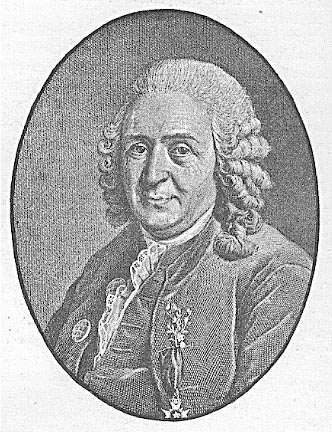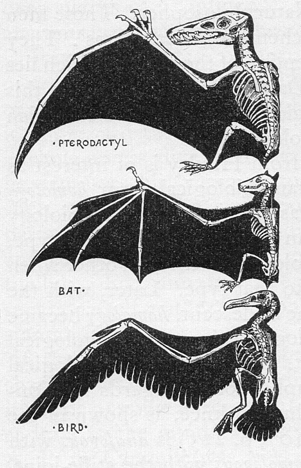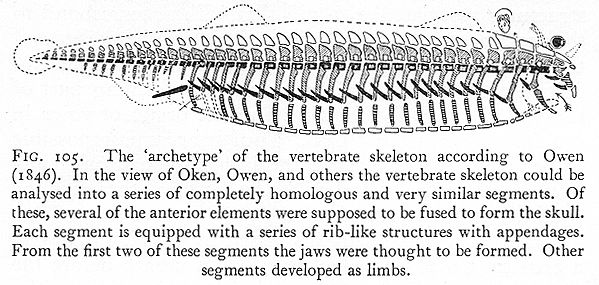
Darwin's Precursors and Influences
2. Common descent
by John Wilkins![]()

![]()
Previous |
Contents |
Next |
Theories of common descent precede Darwin. The earliest I have information of is in a 1745 book by French physicist Pierre Maupertuis, Vénus Physique, in which he also proposed that inheritance was derived equally from each parent, in a particulate form, with something like Mendel's ratio1. Charles' grandfather Erasmus Darwin also proposed it (Zoonomia, 1795, section 39, "Generation") in a speculative passage, where he thought all warm-blooded animals were descended from a single "living filament" created by God, getting closer to common descent for all organisms:
All which seem to have been gradually produced during many generations by the perpetual endeavour of the creatures to supply the want of food, and to have been delievered to their posterity with constant improvement of them for the purposes required.
...would it be too bold to imagine, that all warm-blooded animals have arisen from one living filament, which the THE GREAT FIRST CAUSE endued with animality...? 2
 Linnaeus (right)
Linnaeus (right)
One surprising statement of limited common descent is found in Linnaeus, the great originator of modern taxonomy, who is popularly cited to have thought that species were immutable. In his last editions of his Systema Naturae (1766) he omitted the assertion of the earlier editions that no new species arise, after he observed hybridisation and varietal distribution in plants. He also made the discovery usually attributed to Goethe that all leaves, including flower petals, undergo a common process of development.
The predominant view of species prior to the acceptance of Darwin's and Wallace's views was that they were static: there was a type that individuals both exemplified and more or less approached. This view has its roots in the influence of Aristotle, especially his Parts of Animals, Generation of Animals and On the Soul. Each type has its essence, and divergence from the type is not possible beyond a certain limit of corruption of essence. Too much divergence led to "sports" and "monsters" such as two headed calves and goats without legs, and "degraded types", often used to describe non-European human races. This view was effectively ahistorical, and was most prominent in the German and French speaking countries; it was known as transcendentalism, and in Germany Naturphilosophie.
Richard Owen, a leading anatomist, had developed a transcendentalist view of similarities between types of organisms, and he coined the term "homology" for the similar structures that underlay the different organs of various species3. Thus, a wing on a pterodactyl, a bird and a bat were only analogous since one used feathers and the other a membrane for flight, but the bones and musculature of the different wings were homologous, since they had the same, albeit altered, forms. The wings of a butterfly and a bird were just plain analogous, since the butterfly's wings were not in any way the same structure as a bird's.
Homology (from Romanes' Darwin and After Darwin, vol I)

Owen had attacked Chambers and Lamarck, but he was a progressionist - that is, he accepted that there was progressive change in the geological record, culminating in the appearance of man. Each different group had an "archetype", but archetypes were like an idealised standard body plan, rather than the structure of an ancestor. However, Owen was vague about whether this involved ancestry and what the mechanism of the generation of new species was, and he was certainly influential in that he provided much evidence used by Darwin and especially by Huxley. If Huxley had not been so aggressive in his debates with Owen before the Origin, it is possible he may have later declared for Darwin's theories, but in the event, he was led into a total opposition.
There were many pre-Darwinian evolutionists in the German-speaking countries, and they were not all transcendentalists with no concept of historical descent, particularly those with an interest in the cell theory, such as Matthias Schleiden or Franz Unger, who pictured a single primeval cell (Urzelle) giving rise to all living species. Unger's theory of 1852 can be considered a full-fledged theory of common descent4, although he only applied it to plants. Interestingly, Unger was a teacher of Mendel, and his speculations may have inspired Mendel's work on heredity.
Darwin's friend from Edinburgh, Robert Grant, who had one day astonished Darwin by an enthusiastic outburst in praise of Lamarck, and who was a follower of Geoffroy and Lamarck until quite late in the debate, had been in correspondence with August Schweigger in Königsberg and Friedrich Tiedemann in Heidelberg, and about 1826 or so he along with Schweigger and Tiedemann declared in favour of a common origin for both plants and animals on the basis of the larval stages of corals5. I do not know if they ever made any statement about all life having common ancestry. Desmond (1989) thinks that Darwin may have been more influenced by Grant than he later admitted in the Autobiography but that he minimised the influence because Grant had shown proprietorial behaviour when Darwin once dealt with one of Grant's special interests (Darwin was about seventeen at the time) and also because he wished to mark out his own ownership of "his theory". In the absence of any evidence of Darwin's motivations towards Grant (they remained friends for a while, but Grant's increasing political radicalism scared Darwin, who was a Whig, the party of the middle class), I think that it is unproven, and given Darwin's generous behaviour towards others of his teachers and sources before the publication of the Origin, it is unlikely on balance.
Owen's archetype for the vertebrates was not
unlike Amphioxus, a lamphrey (from E. S.
Russell's Form and Function 1912). 
Darwin's own statement was made by analogous reasoning from the common descent of lineages he had established: "I believe that animals are descended from at most only four or five progenitors, and plants from an equal or lesser number."6 So far, Darwin is not in great opposition to the views of Lamarck, Geoffroy, Macleay, or Owen on the approximate number of major classes of living things. Then, however, he goes on to say
Analogy would lead me one step farther, namely to the belief that all animals and plants are descended from one prototype. But analogy may be a deceitful guide. Nevertheless, all living things have much in common, in their chemical composition, their cellular structure, their laws of growth, and their liability to injurious influences. [Emphasis mine]
It is clear that he thought these arguments influential, and they, or rather more up-to-date versions involving DNA, comparative embryology, and other similarities, are still used today. I do not think the evidence shows that Darwin was influenced in his theory of common descent directly by any precursor, although he clearly was dealing with the same problems set out by Lamarck, Lyell, Grant and Owen that others were.
2 King-Hele 1968, p 85, 86.
3 cf. Ruse 1979, pp 116-125, Mayr 1982, p 464, Desmond 1985
4 cf. Temkin 1959, Mayr 1982, p 390
5 Desmond 1989: p 69f
Previous |
Contents |
Next |

| Home Page | Browse | Search | Feedback | Links |
| The FAQ | Must-Read Files | Index | Creationism | Evolution | Age of the Earth | Flood Geology | Catastrophism | Debates |